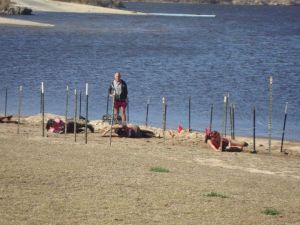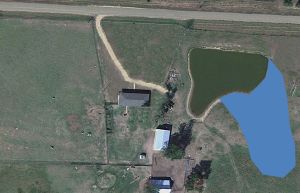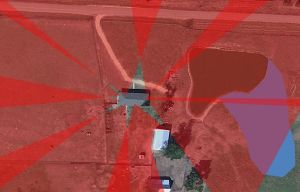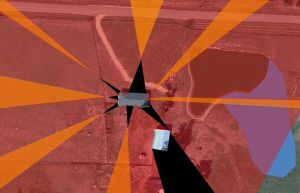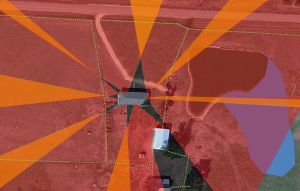OK, back to the grind. I’ve managed to catch up on the work around here after my little overseas soiree and it’s time to start finishing this puppy off. Sometime either later this year or early next year the entire series on terrain is going to get published in an eBook so those that are valiantly printing and saving hold off because I’ve got some additional info and points I’m going to lump in with the existing info once I start editing it down.
In this entry we’re going to begin looking at actually placing obstacles to work for us. A quick recap on what we’ve learned about obstacles thus far: Obstacles serve multiple purposes. They are designed to delay and frustrate a threats movement, funnel or channel the threat to where we want him to go, deny critical terrain to the threat, and buy you time to react. They will not stop a determined threat. And the golden rule of obstacles above all else: anything designed to frustrate a threats movement towards you is likely to frustrate your egress from the area you’ve emplaced the obstacles in.
Alright – we’re going to split this up into two areas, micro and macro. Micro for our purposes is going to be the land you directly control – your homestead. The macro portion is the remainder of your tribal AO and the terrain surrounding it. We’re going to tackle micro first because some of these measures you can take right now. Others might be a bit more conspicuous and you may want to hold off on them.
First up let’s look at our homestead again. Remember in previous entries we cleared some land, felled some trees, expanded our pond (noted by the blue area). Here’s what we have to work with:
In a previous entry we also took a look at fields of fire. Now for the sake of argument for the remainder of this entry we’re going to assume that the folks that live on this homestead are going to defend from the house itself. During latter entries I’ll cover some ways to actually harden the house and its surrounding structures but for now to keep it simple they’re using the house. So what we have to do is actually determine our fields of fire from inside the house to the surrounding terrain. To do that we’re going to use the obvious fields of observation we have – windows. Now when you look out a window to determine a field of fire there’s a golden rule – get the hell back from it. Why? A person in a window is an obvious target. By backing off a couple of feet you reduce your silhouette. The trade off is you also reduce your field of observation and fire. Think about it this way: From a window you have a lot of terrain to observe. Someone looking at the house itself is going to be looking at those windows – a much smaller field of target detection for the threat. By backing off a couple of feet (at least far enough back so your muzzle is still a foot away from the window) you reduce your profile. Now once you’ve decided which windows you’re going to use and determined what you can see on your left and right you’ll want to plot that on a drawing or map. What we’re actually doing here is building a sort of range card – a tool the military uses to identify the characteristics of a defensive position. So we’ve drawn them out and come up with something like this (simplified for the sake of illustration):
The light red areas represent the terrain that we can observe and fire on. We’re going to dig into this one just a bit deeper in the illustration (which looks like a Luchadore nightmare) below.
Notice that I’ve highlighted the areas that were dark red in the previous illustration in orange on this one. This is common terrain that more than one window/position can fire on. The term we’re going to use for that is Interlocking Fires (the old cowboy term for it was crossfire). Interlocking fields of observation and fire are high payoff (meaning they are more lethal for the threat) – simply due to the fact that more than one shooter can engage targets in that area thereby increasing the chance that a threat in that area will be successfully engaged. Interlocking fields of fire are a critical aspect of defense and pretty darn important to how we position our obstacle sin the micro terrain sense. Remember we want our obstacles to channel the threat into our fields of fire and by positioning them to force them into or delay them in our interlocking fields of fire we increase our lethality against the threat. Notice the areas I have blacked out? That is what’s called Deadspace. Deadspace is an area in which you cannot observe nor fire effectively into. When you look out those windows/firing positions you want to make sure you depict that deadspace because deadspace can be lethal – to you. The threat can use deadspace to move closer to its objective with less chance of being observed and engaged so finding and dealing with that deadspace is critical. More on it below.
Now we’ve established our fields of fire we’re going to look at what we have in the way of existing obstacles – which is probably fences. In the illustration below I’ve overlaid the existing fences in relation to our fields of fire and deadspace. We’re looking decent to the west and east with good coverage however notice we’re lacking in the north and south/southwest.
What we have to do is determine where and what kinds of obstacles we’re going to emplace in the immediate vicinity of our house to work to our advantage and offset our defensive weaknesses (which includes the aforementioned deadspace). So let’s plug a few additional fences and wire obstacles into our layout and see how it looks.
In this illustration I’ve depicted our additional immediate obstacle with blue lines. To the west we have excellent coverage and good interlocking fields of fire and observation so the placement isn’t so critical however I’ve placed additional fencing in to frustrate the threats lateral (north to south) movement in that area. Remember the longer a threat is in your field of fire dealing with an obstacle the longer you have to engage them. To the north we’ve done basically the same thing. To the west notice how the fencing has run all the way to the expanded pond? With the way that area is laid out in relation to the pond it’s going to be what we consider a less-likely avenue of approach for a threat on foot during a direct assault. In some of the other areas we’ve fenced our deadspace off to help prevent threat movement into and out of that deadspace . The key here is Frustrate the threat’s movement, Delay him in your field of fire, and Deny him easy access to your deadspace.
And now we have to deal with our deadspace. First off – is that amount of deadspace realistic? To the north probably not so much. Houses typically have quite a few windows facing the normal main avenue of approach (which in our case is the road). You’ll encounter normal headspace immediately around your field of observation/fire (think below or immediately beside a window) and beyond any structures. Which brings us to the sore thumb in this illustration – that huge amount of deadspace to the southwest. That deadspace is something that just can’t be ignored, it’s too close to our position – well within hand thrown ordinance. How do we deal with it? Well, you can evaluate it against the remainder of your micro terrain and against your macro terrain (maybe there’s another homestead between those building in the illustration and the threats’ main avenue of ingress) and make a decision whether to level it or leave it standing. Leveling it and the other offending structures will probably cure your deadspace issue but that may just not be an option – especially if you’re trying to keep your homestead productive. Another option could be to wire it completely off – once again that may be too great an impact on production. Sow some nasty little surprises for a threat that tries to use that area? Your decision but personally I wouldn’t want them that close to the homestead where one of my family or livestock could stumble across them. Early warning devices? More acceptable. Another option is to establish a bunker or developed fighting position to cover that deadspace. Once again this has pros and cons. Fighting positions are only effective if they’re being fought from and if you have reaction time to get to them. All the foxholes, trenches, and bunkers in the world do you no good if they aren’t manned. So weight that decision against your capabilities and resources. If you have inbound family during a SHTF scenario maybe that’s a good place to position them. If you go that route then remember – you have to have some form of comms between the main house and that developed position to maintain situational awareness. Handheld radios, wire, whatever. If you go that route plan on developing a system by which you can get as much early warning as possible from that direction. If I had to place a position in that area I’d probably put it somewhere near the star in the illustration below. That position could provide some observation and fire on that deadspace while still being in a position to be supported by fires from the house but for the reasons I’ve outlined above could prove to be a liability.
It doesn’t really take a lot of effort to take the time to look around your micro-terrain (your immediate land) and asses what your fields of fire and observation are. Weigh your defensive plan against where and how the threat can or may come at you and place the obstacles we’ve covered in this series up to now to capitalize on interlocking fields of observation and fire.
Note in this entry we didn’t get a whole lot into Defense In Depth. I’m planning on tying that in when I address ways and means to actually harden the house itself. Defense in depth on a 360 degree front is a can of worms for a small (think 5 or 6 household members) group and it deserves its own entry.
Next up we’ll start assessing our macro terrain at the tribal level and cover some things like obstacle parties. Till then keep the powder dry and the pantry stocked.

